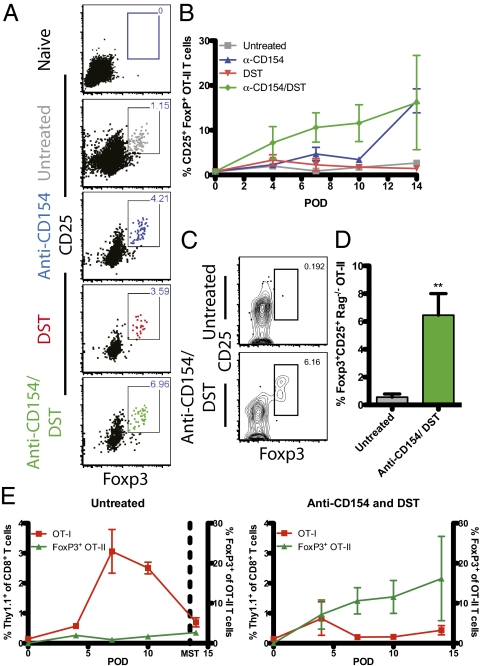Fig. 5.
Anti-CD154 and DST treatment promote conversion of donor-reactive CD4+ T cells into CD25+ Foxp3+ iTreg. (A) Day 7 concatenated flow plots of OT-II (Thy1.1+) T cells in LNs, with gates on CD25+ Foxp3+ OT-II cells. (B) Longitudinal analysis of Foxp3+ OT-II T cells. On day 7, the frequency of Treg in untreated mice was 0.88% ± 0.44% that of OT-II T cells. Anti-CD154 (4.68% ± 1.49%; P = 0.071) and DST (2.27% ± 1.37%; P = 0.389) monotherapies slightly increased the frequency of Foxp3-expressing T cells within the OT-II T-cell compartment. Anti-CD154/DST significantly increased Foxp3 expression in OT-II T cells compared with untreated controls (10.61% ± 3.28%; P = 0.042). On day 14, both anti-CD154 and anti-CD154/DST reached similarly high levels of iTreg conversion (16.57% ± 2.68% and 16.17% ± 10.53%, respectively; P = 0.973). Data are summarized from three experiments with three mice per group. (C and D) B6.SJL (CD45.1+) were adoptively transferred with OT-I and RAG−/− OT-II T cells and treated with anti-CD154/DST. On day 7, draining LNs were analyzed for Foxp3-expressing OT-II T cells. (C) Representative flow plots of CD45.2+ RAG−/− OT-II T cells; gate represents CD25+ Foxp3+ iTreg cells. (D) Combined CD154 blockade and DST significantly increased the conversion of OT-II T cells into Foxp3+ iTreg compared with untreated controls (6.452% ± 1.552% vs. 0.559% ± 0.225%; P = 0.0035). Data are summarized from two experiments with between three and five mice per group. (E) Relative frequencies of Thy1.1+ OT-I T cells compared with peripherally converted Thy1.1+ OT-II iTreg from untreated LNs (Left) and anti-CD154/DST–treated LNs (Right). OT-I T cells are measured on the left y-axis, and the OT-II Treg are measured on the right y-axis. Data are summarized from three experiments with three mice per group. Values are mean ± SEM.

